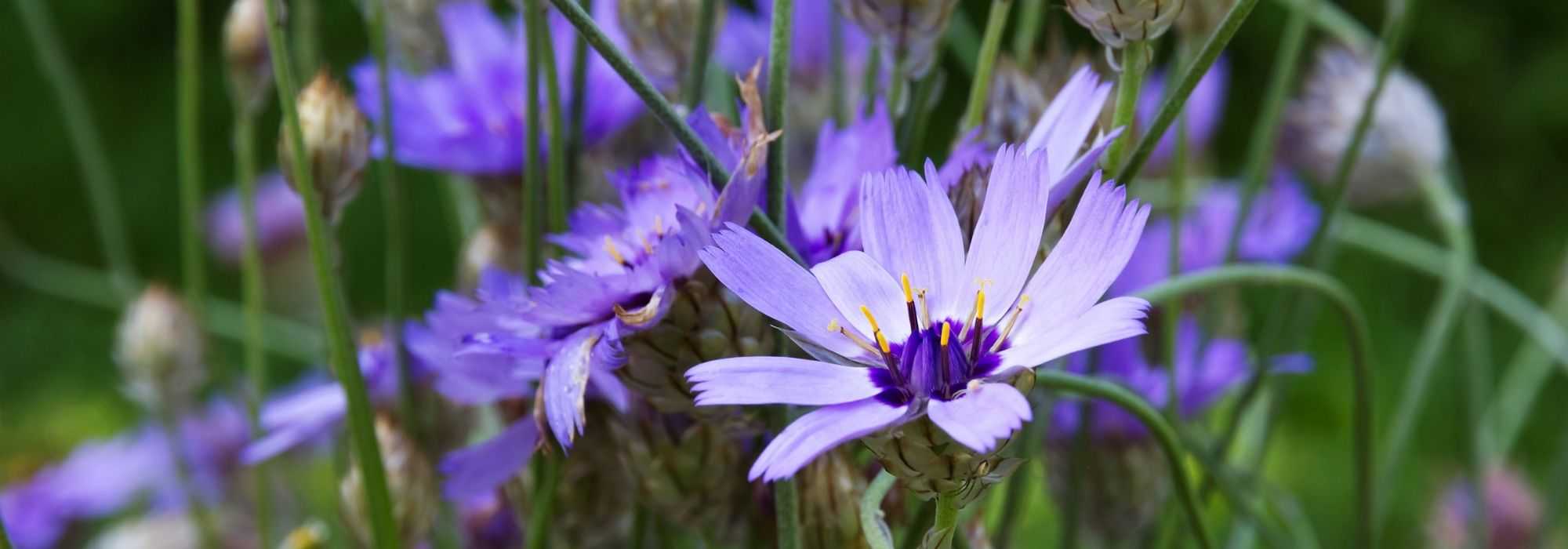
Catananche, Cupid's dart: pairing it in the garden
5 ideas for combinations for 5 different atmospheres
Contents
The Catananche is a charming Mediterranean perennial valued for its generous summer flowering, featuring blue or white star-shaped flowers atop slender stems that rise above a tuft of fine, glaucous evergreen foliage. Very accommodating, drought-resistant, and tolerant of sea spray, its translucent bracts make it a long-lasting decorative plant, also used in dried flower arrangements. Fast-growing and fairly hardy, it thrives in sunny locations and well-drained soils, including calcareous ones. All these qualities, combined with its natural and relaxed appearance, make it easy to incorporate into various landscaping designs. In this article, I invite you to discover 5 settings built around the blue Cupidone, with companion plants that enhance or support it, creating beds full of cheer and colour!
–> All our tips for planting, growing, and caring for Catananche, as well as our different varieties of Cupidones
A sunny, dry limestone bed.
Not always easy to garden in calcareous soil, especially when the soil is dry and the sun is beating down. Fortunately, Catananche is not the only plant that can thrive in these seemingly uninviting conditions. When it comes to bushes, Lavender is a classic, spreading its scents reminiscent of holidays. Another interesting option, albeit with deciduous foliage, is Perovskia, a bushy perennial with long upright stems of silvery grey, accentuated by flowers in a blue reminiscent of certain Lavenders. Rosemary, with its earlier flowering, can serve as an introduction, forming more or less upright or prostrate bushes depending on the species. The grey foliage of a Wormwood like Artemisia ‘Silver Queen’ displays a beautiful neutrality, linking other colours together, and its white flowers also harmonise with all shades. For broader foliage, but still very graphic, Senecio ‘Angel Wings’ is best reserved for regions with mild winters. Perennials offer a wealth of interesting subjects alongside Cupidone, such as Eryngiums, decorative architectural thistles appreciated for their intricately carved inflorescences in electric blue with an inimitable look. To break away from blue and grey, consider other sun-loving perennials for dry soil, such as Achilleas, which come in a wide palette of colours, and whose flat inflorescences create a lovely contrast, Valerianas with their long and generous flowering, or even Verbascums, which provide vertical punctuation in a border. In the foreground, opt for perennials with a low and spreading habit, such as Moss Phlox, Sea Thrift, and Creeping Sedums. Finally, create movement with the light spikes of ornamental grasses: the classic Angel Hair is perfect for this use, but also try taller grasses, like Ampelodesmos mauritanicus, which deserves to be used more often.
–> Is your soil basic? Here are some very useful tips for a beautiful garden in calcareous soil!
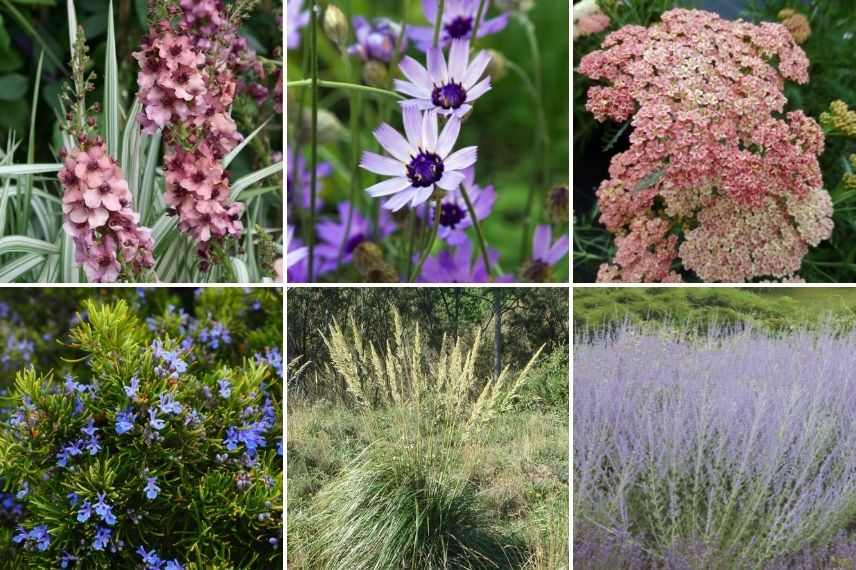
Hybrid Verbascum ‘Southern Charm’, Catananche caerulea, Achillea millefolium ‘Peachy Seduction’, Rosmarinus officinalis ‘Prostratus’ (photo pixabay), Ampelodesmos mauritanicus (photo Xemenendura) and Perovskia ‘Blue Spire’ (photo pixabay)
Read also
Growing Catananche in a potAn orange and blue flowerbed
Blue and orange are two complementary colours that pair very well, each enhancing the other. The Cupidone already offers blue flowers, but feel free to combine it with other perennials in similar shades. Play with the shapes of the flowers, the height of the plants, and also the available shades, from the darkest blue to the lightest blue, including intermediate tones like lilac. Among the blue-flowering perennials, we can mention some Columbines (with single or double flowers), the Aster ‘Goliath’, many Campanulas (to use as groundcover or structural plants depending on the species), Hardy geraniums (‘Azure Rush’ or the tireless ‘Rozanne’ for example), the Italian Bugloss ‘Loddon Royalist’ (a saturated and intense blue), the Baptisia ‘Blueberry Sundae’ (much more accommodating than lupins), the Eryngiums (spiky, indeed, but with incomparable graphics), some Irises (which offer a very wide range of different blues), the Field Scabious (with pompom flowers that look very natural), the essential Nepetas and Lavenders, or even many Sages. Blue can also be only partially present, mixing with white, as seen in the very beautiful Agapanthus ‘Fireworks’, or emerging from variegated foliage to create a surprise, as is the case with the Caucasian Speedwell ‘Variegata’. Next come the oranges, which are also very varied in their hues and intensity. The Agastache ‘Kudos Mandarin’ features tubular flowers in a beautiful copper orange with a somewhat exotic look. Also try the cream orange of the Yarrow ‘Terracotta’, the apricot of the Avens ‘Totally Tangerine’ with double flowers, the sunset shades of the Echinacea ‘Sundown’, or the bright orange of a Daylily. To this list, we could add the Iris ‘Good Show’ in pure orange or the changing foliage of a Heuchera ‘Timeless Orange’, whose flowers also adhere to the colour scheme.
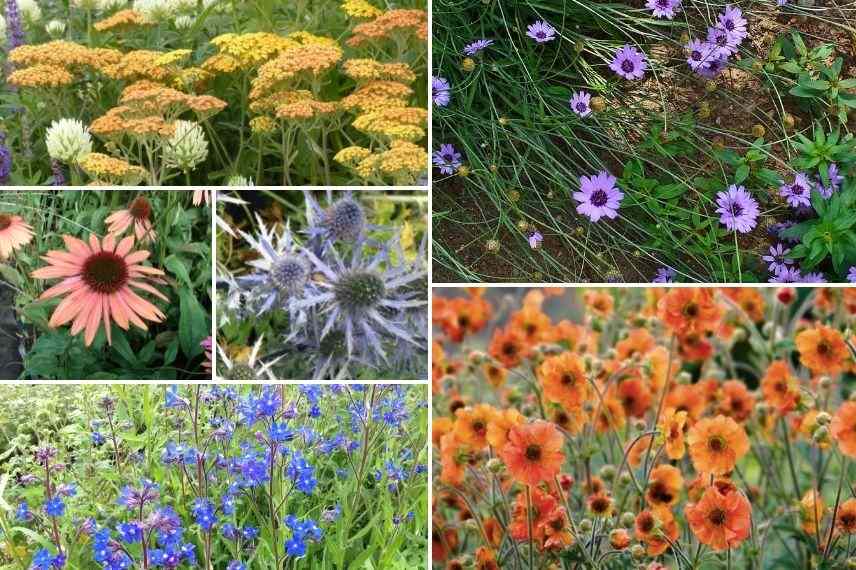
Achillea millefolium ‘Terracotta’, Catananche caerulea (photo Wikipedia), Echinacea purpurea ‘Sundown’, Eryngium bourgatii ‘Big Blue’, Anchusa azurea ‘Loddon Royalist’ and Geum ‘Totally Tangerine’ (photo PBK)
Discover other Catananche
View all →Available in 1 sizes
Available in 2 sizes
Available in 1 sizes
Available in 1 sizes
Available in 1 sizes
A mineral garden, for serenity and simplicity
Gravel gardens have the advantage of requiring little maintenance, no watering, and they provide drainage conditions suitable for Catananche, as well as other perennials and bush species that thrive in free-draining soil. The Butterfly Bush fills the air with its honeyed scents all summer long, and its dense spikes attract pollinators. Some varieties are sterile and do not self-seed, such as Buddleia ‘White Chip’, with its white clusters, or Buddleia ‘Unique’, which is blue; both are dwarf varieties. Flowering a bit earlier, the Ceanothus come in blue, white, and pink, and their diverse shapes are an asset for structuring a display. Pines also make excellent subjects for mineral gardens. Prostrate varieties, like Pinus strobus ‘Horsford’ (35 cm), or more upright ones (Pinus nigra ‘Green Tower’ has a conical and slender silhouette of 4m), remain decorative all year round, and their foliage allows for interesting plays on textures and colours. When it comes to perennials, the choice is vast. For blooms that coincide with those of Cupidone, try Gauras, Pinks with their old-fashioned charm, or Sages. Salvia ‘Blue Note’, shrubby, boasts an incredible royal blue, while Salvia ‘Knockout’ has lilac-white flowers that create a beautiful contrast with its very dark foliage. Earlier in the season, Silver Basket, Aubrietas, some Euphorbias, and Moss Phlox guarantee cheerful and vibrant colours. To close the season and bring colour in autumn, focus on Sedums: in addition to timeless varieties like Sedum ‘Autumn Joy’ with its beautiful flat inflorescences, there are varieties with very dark foliage (Sedum ‘Purple Emperor’ is a stunning example) as well as ground-cover species, such as Oregon Stonecrop. Asters, like Aster ‘Asrugo’ with its lovely acid pink flowers, easily complement the colour palette, not to mention the elegant silhouettes of ornamental grasses, some of which reveal the beauty of their spikes at this season.
–> How to design a mineral or gravel garden? All our tips and suitable plants.
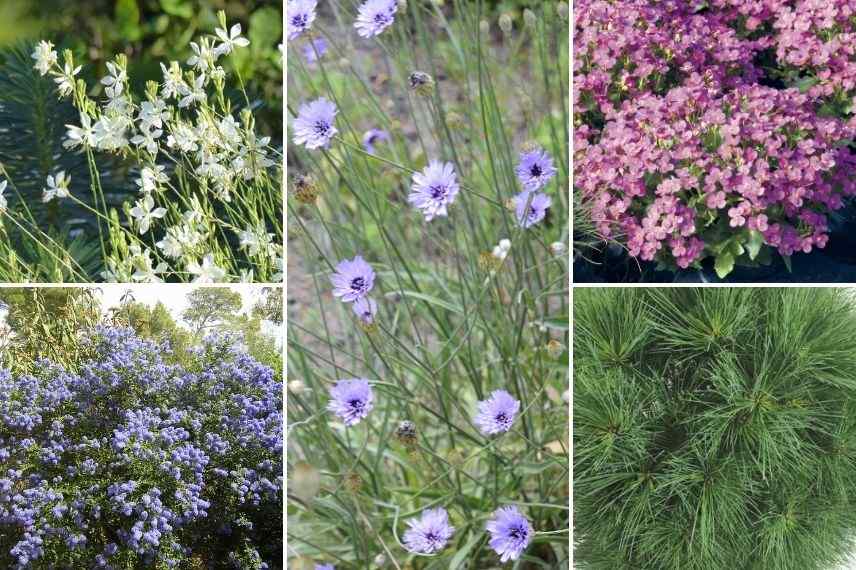
Gaura lindheimeri ‘Snowbird’, Catananche caerulea, Arabis alpina caucasica ‘Roselite’, Ceanothus thyrsyflorus ‘Repens’ (photo Kousvet2) and Pinus strobus ‘Horsford’
In a seaside garden
Coastal gardens often benefit from a mild and humid climate (except for the drier Mediterranean coast), but they can be quite windy and subject to salt spray. Catananche may lie down under strong winds, but if placed in a sheltered spot or surrounded by supporting plants, it has a rightful place in a coastal garden. You can provide it with a beautiful backdrop made up of a Mexican Orange Blossom, whose evergreen foliage and repeat flowering exude citrus fragrances. Pittosporums come in green, variegated, and even nearly black foliage (Pittosporum ‘Tom Thumb’), and are also evergreen. They create stunning ball-shaped accents. You can pair these two bushes with larger subjects that have a more upright habit, such as Tamaris (white or various shades of pink, flowering in spring or summer depending on the species) or Lagerstroemia, large shrubs that are interesting for their colourful late summer flowering as well as their autumn foliage and bark, which remains decorative even in the heart of winter. If you are tempted by exoticism, let yourself be charmed by Grevillea or Callistemons, two shrubs that transport you to Australia… In front of these sturdy plants, plant your Cupidone, alongside Agapanthus with beautiful blue, white, or bicoloured inflorescences, held atop robust stems. Interspace with large perennials that also have a strong graphic presence, such as Eryngiums in bluish or metallic tones, as well as more airy neighbours that lighten the overall effect, like Gauras (white or bright pink) and Buenos Aires Verbenas, which also flower for a very long period! Complete with some grasses or similar plants, such as tall Upright Panics (some are stunning in late season) or clumps of Carex, with fountain-like evergreen foliage. If there are any empty spaces in the foreground, why not fill them with Sea Thrift or Shrubby Veronicas (some are quite small)? To finish, wake up spring by planting here and there some groups of early flowering bulbs.
–> Coastal gardens: constraints, advantages, solutions… we tell you everything in our advice sheet.
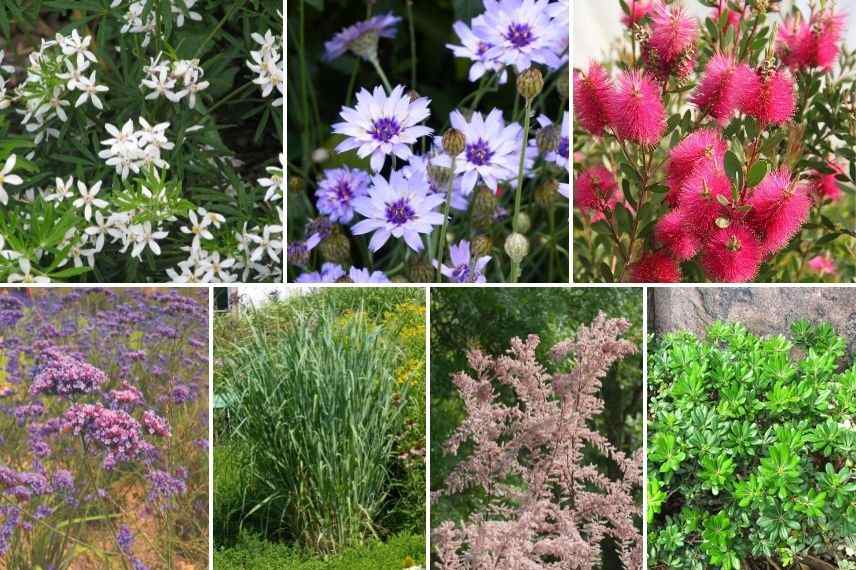
Choisya ‘White Dazzler’ (photo peganum), Catananche caerulea, Callistemon viminalis ‘Hot Pink’, Verbena bonariensis, Panicum virgatum ‘Dallas Blues’, Tamaris tetrandra and Pittosporum tobira
English romantic atmosphere
Very versatile in its uses, Catananche can indeed take centre stage in an English-inspired border with strongly romantic accents. Inevitably, such an atmosphere is particularly well-suited to roses. Select roses such as ‘Novalis’, ‘Blue Girl’ or ‘Nautica’, whose lavender hues echo those, quite similar, of Cupidone. Another option is to work with complementary colours using roses with orange or salmon blooms, such as those of ‘Westerland’, ‘Calizia’ or the famous English rose with fully double flowers, ‘Pat Austin’. Finally, if you prefer neutrality, opt for white with the classic ‘Iceberg’ or, for small gardens, ‘Schneeküsschen’, a dwarf rose reaching 40 cm in height.
Complete the scene with perennials that have spike-like blooms such as those of Agastaches, Delphiniums, Digitalis, Persicarias, or some Veronicas, all of which provide a beautiful contrast of forms, with verticality. Still aiming to create contrasts, scatter a few clumps of Agapanthus or ornamental Alliums with their lovely round heads as well as groundcover plants like hardy geraniums (again, you can choose blue or white depending on the colour palette you have selected). Perennials with decorative foliage are often interesting for much longer than those with flowers. Thus, in partial shade, you can opt for Heucheras, which offer an incredible range of colours! Plants with grey or silver foliage, like Artemisias, lamb’s ear, or mouse ear help to highlight the blooms while also linking the colours together, to avoid a cluttered effect. In a romantic border, grasses also have their role to play. The foreground is ideal for Carex and fescues, which form beautiful cushions with a languid habit and varied hues. In the back of the border, focus on Miscanthus, erect Panics, Calamagrostis, Molinies or giant Stipa, which remain beautiful for a long time, are easy to maintain, and graceful both in the wind and under low light. Finally, bring forth the first colours in spring with bulbs: snowdrops, daffodils, crocuses and tulips are widely praised for their ease of cultivation and the joyful touches they create in borders, before perennials, bushes, and grasses awaken.
–> Get inspired with this selection of plants for a romantic garden.
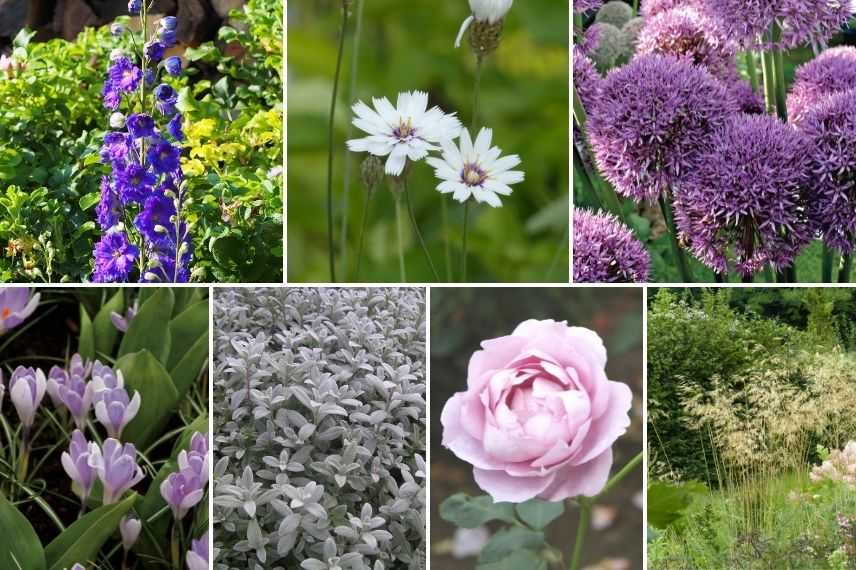
Delphinium ‘Pagan Purple’ (photo FD Richards), Catananche caerulea ‘Alba’, Allium ‘Pinball Wizard’ (photo Mike Peel), Crocus vernus ‘Vanguard’, Cerastium biebersteinii (photo Wikipedia), Rosa floribunda ‘Novalis’ and Stipa gigantea
- Subscribe!
- Contents
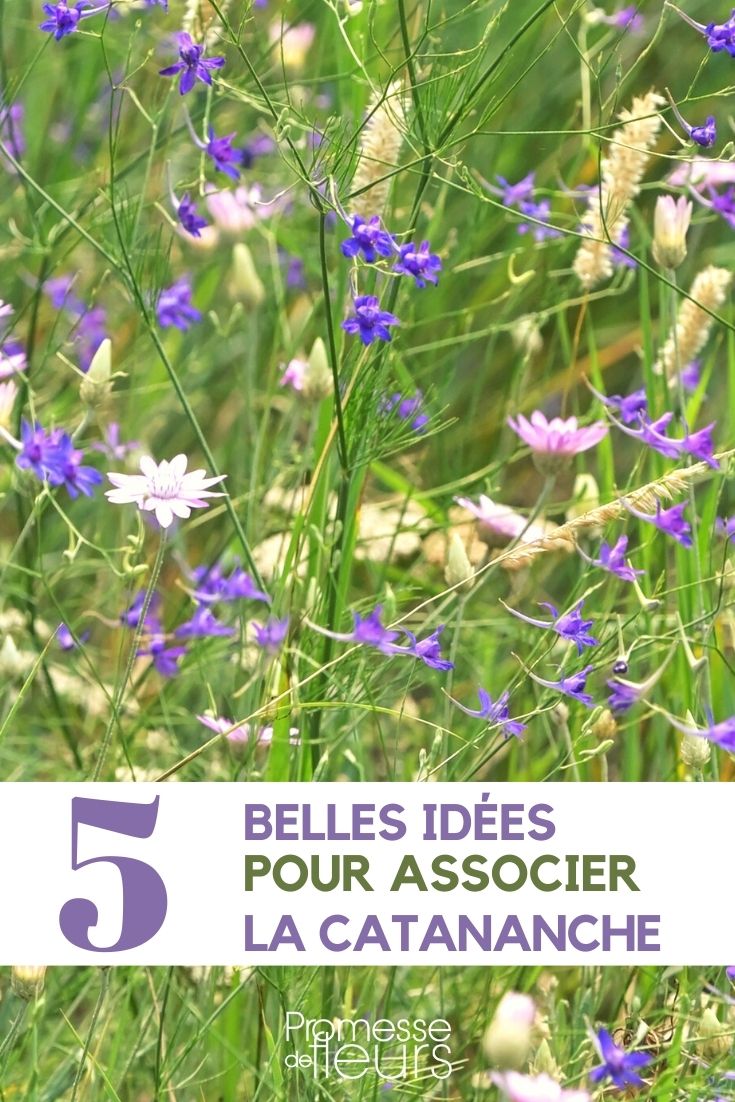































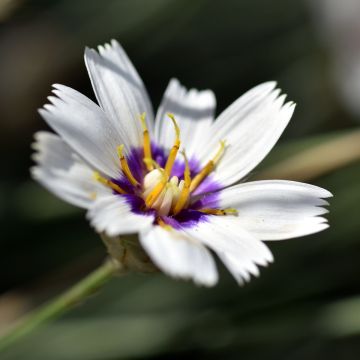
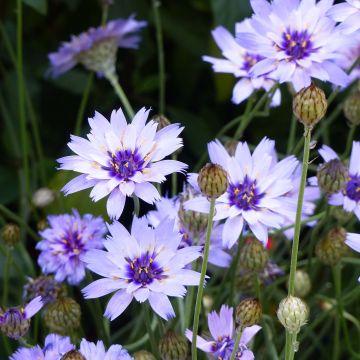
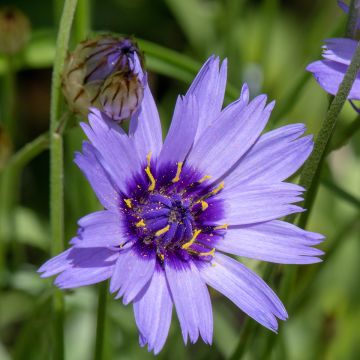
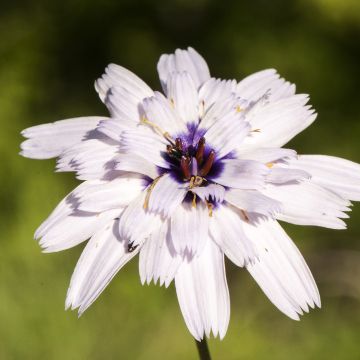
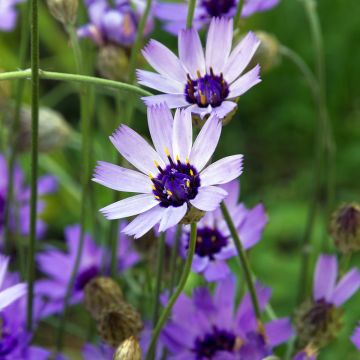
Comments